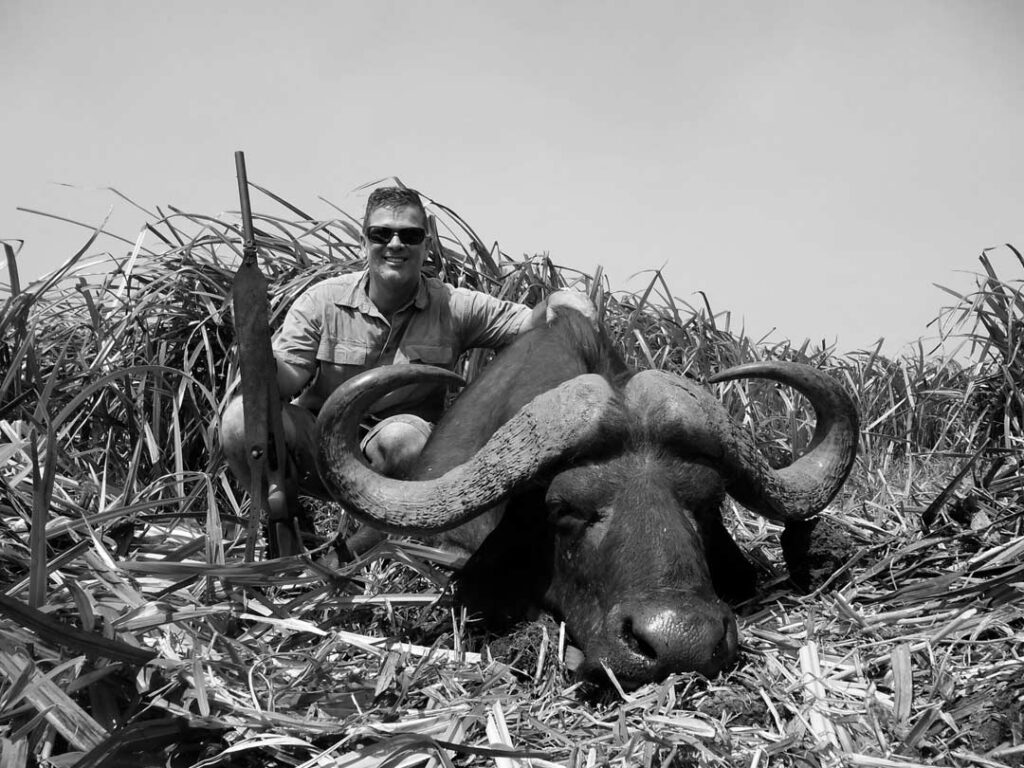A few years ago, I received an invitation from an outfitter advising he had a few end-of-season discount hunts available to do dangerous game hunting in Africa. More specifically, in Northern Mozambique, near the Marromeu Reserve for Cape buffalo. When chatting to a good friend of mine, Sheldon, it sounded like an awesome suggestion, and we decided to book for Buffalo hunting in Mozambique!
[DYNAMIC-BLOGTABLEOFCONTENT]
The hunting adventure began with thorough planning of all the normal logistics, transport, calibers, firearm permits, and a request to ensure my last will was updated! This is a normal request when, especially Africa’s notorious black death.
We calculated that the best option was to hire a small Cessna five-seater and fly out from Polokwane, South Africa, as in these remote areas, commercial flights are not always available, even when using smaller airlines. Bush landings are not always an option, and flooding in the regions makes the terrain a huge challenge, even in a Toyota Landcruiser. I have fond memories relating to our pilot communicating with the Mozambique air traffic control as we entered the Mozambican air space. “November Charlie Yankee, with four plus one at 20,000 feet with an E.T.A. of one hour coming in from a southerly direction…” and so forth, only to be answered with an “OK” from local authorities!
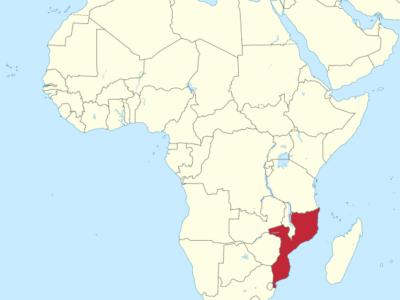
How much does it cost to hunt Cape buffalo in Mozambique?
Big game hunting in Mozambique in recent years has become very popular. Since 1994, the number of animals has drastically increased since the nation’s civil war ended in 1992. Cape buffalo numbers had plummeted from an estimated 45,000. Unverified rumors were rife of Russian gunships firing on herds of buffalo, and sending the animals out to the canning ships. The region that once had abundant wildlife, seemed to have fallen victim to the violent struggles for power in Mozambique. Mozambican locals who once operated as poachers are now employed by many outfitters, and their bush skills, knowledge, and tracking are put to good use. Today, Cape buffalo numbers have reached over 50,000, and numbers are classified as particularly healthy. Elephants, lions, leopards, crocodiles, and hippos are readily available in the northern areas.
These three species should all be shot one-third of the way up near the shoulder. No one wants to be chasing after any one of these predators if they are wounded so good shot placement is critical. If one of these animals is facing you directly then you should aim for the base of the neck and central in the legs giving you a sweet spot in the chest.
The Cape Buffalo
Big game hunting comes with many challenges, disappointments, and rewards. Cape buffalo are considered one of the most dangerous animals in Africa and, in my opinion, have a special place in all trophy rooms. Old bulls known as “dagga” boys, which means “mud” in local dialect are bulls that have left the herd and are generally far more aggressive, and they all seem to have permanently bad tempers.
It is a common saying that a buffalo looks at you as if you owe him a chunk of money, and you are behind on your payments! They are menacing beasts growing up to 2,000 pounds, and are one of the most popular big and dangerous game animals to hunt. Not looking like ancient warriors, buffaloes are often overlooked in favor of carnivorous predators that give the perception of being more dangerous. Do not be fooled, they are exceptionally tough animals.
A buffalo has a top speed of 80 miles per hour and will give you no warning of a charge. Nothing, except a well-placed bullet, will stop the old boy. Cape buffalo hunts are action-packed from sunrise to sunset. A buffalo will find and kill you, the hunter becomes the hunted. It is just that simple.
What is the shot placement on a Cape buffalo?
- Shot placement is a third of the way up directly above the front shoulder, ensuring a heart or double lung shot.
- Head and neck shots should be avoided, as they can potentially be high-risk.
- On a charging buffalo, assuming there is no solid and easily accessible tree to climb, a brain shot is your only option when having to stop him.
- With the head bobbing up and down, and knowing that the brain is only 4.7 inches, the kill shot will need to be 15 yards away.
- The Cape buffalo is responsible for about 200 deaths annually, second only to the hippo.
Rifles, Calibers and Bullets
When planning your big game hunting safari, what is the best caliber to bring is always asked? I would firstly check what your outfitter has available, as in some instances it is a real pain and plenty of admin moving firearms from continent to continent. Of course, you have a special attachment and emotional attachment to “her” which is a totally different ball game!
The .375 caliber is the minimum caliber allowed for big game hunting, including the Cape buffalo. When it comes to buffalo hunting, I believe the bigger the better. Maybe a .416, .458, or a double rifle capable of shooting at least 570 grains at 2,100 feet per second. You cannot have too much stopping power on buffalo hunting in Mozambique.
When it comes to scope or not, terrain generally answers that question. Some buffalo are shot from as far as 200 yards away, and follow up for the “Coup de Grace” at 15 yards. The first prize would be able to switch from a scoped rifle to open sights. If you have any doubts, contact your professional hunter for his advice. He will know what is best.
Planning the Buffalo Hunt
I decided to take my .458 Remington and Loaded 500-grain monolithic tips. As my scope had a 1-8 magnification, I thought I could get a little range as needed, but it would also work if we got up close and personal. Sheldon requested to share my rifle to save paperwork, to which I agreed. The .458 Remington is exceptionally light and comes with quite a serious recoil, of roughly 70 pounds. The outfitter called a few months before the hunting safari and suggested that we practice walking over tough terrain, as we would cover plenty of distance during the hunt. These hunting concessions are huge, and not very accessible except on foot. I took his advice and started doing some buffalo hunting training.
The Cape Buffalo Hunt
The camp had all the usual amenities expected from a remote bush camp. No cell signal except via satellite phone, comfortable rooms, pleasant dining and bar areas. We started day one with a check that the .458 was in and on the money. She was working like a charm. I had packed 100 bullets only to find out that the maximum allowed was 40. Luckily, the local police authorities did not think checking the ammunition was on their to-do list!
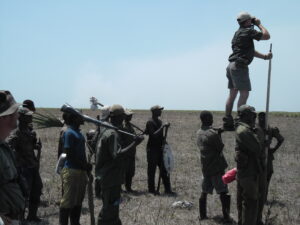
We packed our goods and were ready to leave the camp. We were a group of three hunters, two trackers, a few skinners, and staff allocated to carrying water. I thought one crew member to carry my allocated 20 liters of water was a bit excessive. We were followed at about two hundred yards by at least twenty locals, walking without shoes, food, or water. This party was around just in case we were successful, and they maybe were allocated a few “scraps” of a carcass, as allocated meat was for other local communities. It was heart breaking to see such poverty and desperation. Imagine putting in a full day’s effort while hoping to receive a few grams of intestine, brain, or stomach. Conditions in Africa are brutal.
Mozambique buffalo hunting is not for the faint-hearted. The conditions, in my opinion, were horrific or truer to a definition of a proper African buffalo hunt in Mozambique. We walked and crawled through swamps and cutgrass, which ripped at your clothes and skin. Some areas were so flat that we could not see a thing and had to lift members of the hunting group on poles to see what may be ahead.
By noon, I had almost demolished my entire water supply. I had about 5 liters left. Your body loses water quicker than you can replace it. Out here, the blazing sun is your biggest and most dangerous enemy. A short while later, we stopped abruptly, and went down flat, crawling through the cut grass. Ahead of us was a herd of about 600 buffalo strong. We glassed the herd, and the PH pointed out a few possible bulls. Honestly, all the buffaloes seemed to look the same, except obviously for the calves. We started to identify possible bulls by counting ox peckers, body stances, etc. I asked how far out, and the professional hunter said about 200 yards. I thought he was talking nonsense, as he had an interesting sense of humor. He knew I was in at 80 yards, and looked more like 300 yards. This hunting safari was becoming tricky. We agreed on a bull, and I set up my rifle. Taking a deep breath, I aimed and squeezed the trigger. Nothing beats the smell of gunpowder when safari hunting in Africa! The bull did nothing. None of the other 599 buffalo did anything either. I must have missed him by a mile and underestimated the trajectory of the bullet at that distance. My kids always laugh and say I did not miss one buffalo, but 600 buffaloes!
Luckily the next shot rang true. We heard the solid thud of the bullet and saw the buffalo give a slight dip. The entire herd bolted. In this environment, a wounded buffalo will usually separate from the herd, allowing easier tracking and follow up on any blood spoor. Tracking a wounded buffalo through two meters of cut grass is exhilarating! It is difficult to be silent, and visibility is poor. I suddenly remembered the request to update my will…
One must have the utmost respect for the fearless African trackers. Stalking further through the swamp, the PH suddenly raised his arm and told us to stop. Adrenalin was pumping. He whispered, “I just need to take a pee!” What, in the middle of buffalo stalk?
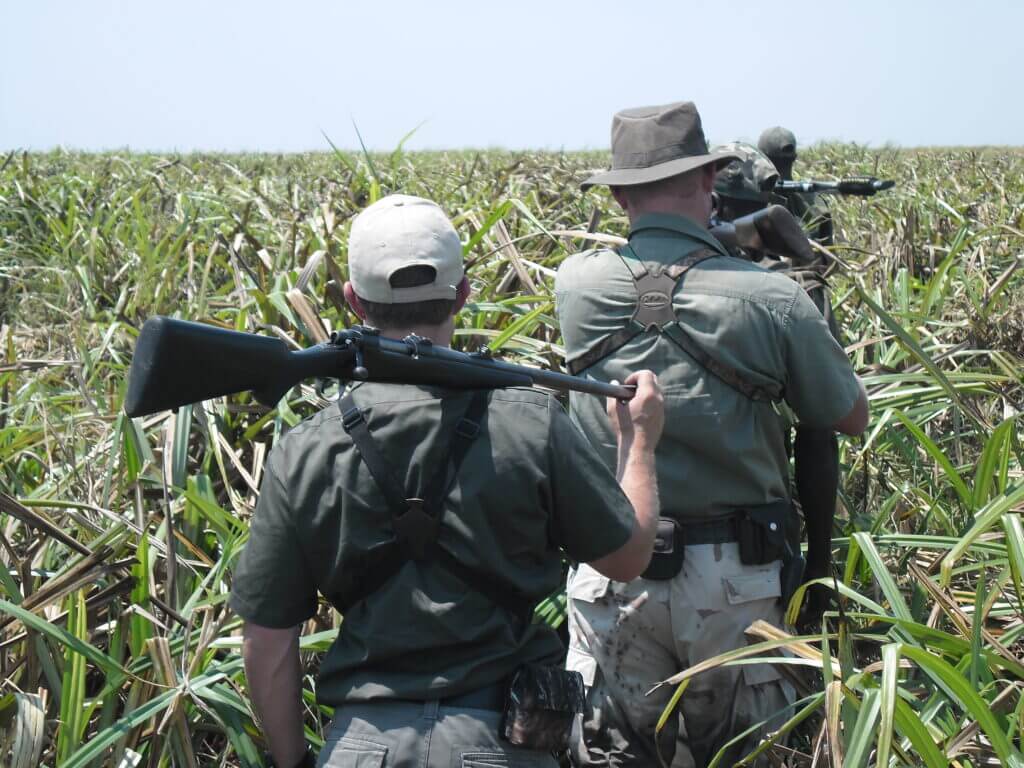
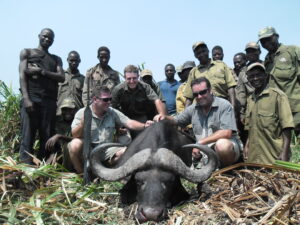
We agreed due to poor conditions, that if that buffalo came out charging, we would have limited time available and thought the best strategy would be to all throw lead and try to turn him. That is exactly what happened. We found him about 100 yards out and man, was I happy. This was one of my favorite African hunts.
The .458 drew blood a few more times later that afternoon. The first when the recoil opened Sheldon’s head above the eye, and a few more to bring down his buffalo, our second Cape buffalo for the day. God was smiling down on us.
The walk back seemed like it would never end. At this point, I was delighted about putting in all the miles during the months leading up to the hunting safari. Collapsing near the Land Cruiser at sunset, my water supplies long gone, I realized how privileged I was to have this unique big game hunting experience. The ice-cold beer waiting for us in the middle of the African swamp lands proved again what a dedicated and committed outfitter this was. An absolute legend.
This hunt reminded me of a conversation I had had with the PH while hunting hippos in Namibia. The PH said they are not just professional hunters, but dream makers. Those words have always stuck with me, and this African hunt was a dream come true.
That night around the fire, we realized that we had hunted and been successful with both buffaloes on day one of the hunt. Deep down, I know I could not have walked another few days in those conditions.
As our little plane was available, we decided that while we were in Mozambique, we might as well go deep-sea fishing. We caught some enormous yellowfin tuna and once again fed happy island residents.
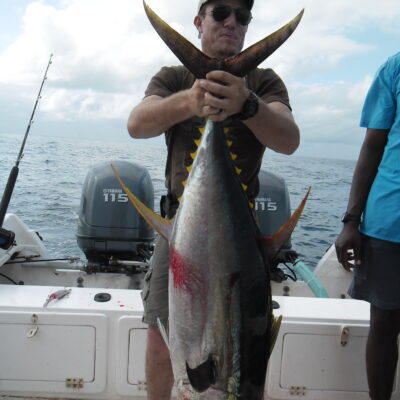
Experience the Thrill of Big Game Hunting
Hunting in Africa is affordable and exceptionally rewarding. If you are planning a big game hunting safari, consider Mozambique. It is a safari hunting trip that certainly should be added to the bucket list. If the thought of chasing Africa’s black death or big game hunting in Mozambique tickles your fancy, check out these available hunts. Alternatively, contact us for a custom-made hunt.
Author: Pierre van Wyk
